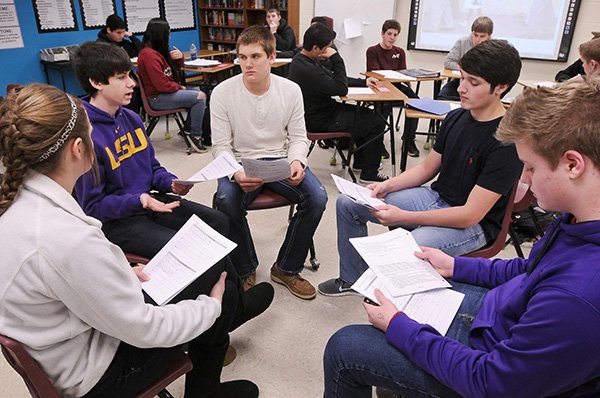BENTONVILLE — Mouie Lanje, 16, was sitting in the “hot seat” in the middle of his sophomore English class at Bentonville High School when he asked his classmates what it would be like to live without basic human rights.
“I was thinking I would feel trapped and mad,” he told them. “I wouldn’t have the rights to do what I want to do.”
Lanje was reflecting on his feelings after seeing videos, viewing art and reading about the nation’s history of racial discrimination, particularly in the 1950s and 1960s.
With high schools across Arkansas implementing the Common Core State Standards in literacy and math this year, sophomore English teachers at Bentonville High School scrapped their lessons and units and started from scratch. By the 12th grade, the standards state 70 percent of what students read in all subjects should be informational text, which could include speeches, opinion pieces, essays and biographies.
For the third quarter of the school year, Bentonville High School sophomore English teachers chose to study Martin Luther King Jr.’s Why We Can’t Wait, which includes his famous “Letter from Birmingham Jail,” teacher Heather Thompson said. The standards for studying informational text suggest ninth- and 10th-graders analyze seminal U.S. documents, such as King’s letter.
On the Common Core Standards website, it says standards for informationaltexts were included because reading in college and workforce training programs is often informational and challenging.
“Non-narrative, it strikes fear in our hearts,” Thompson said. “It’s just finding the right piece.”
Thompson’s students have just started reading King’s book. While most students have heard King’s name since elementary school, several students said this is the first time they’ve read what he wrote.
Thompson has led up to a close analysis of King’s words by helping students think about an author’s purpose and point of view.
Students have watched videos about key moments in the Civil Rights movement, including the murder of Emmett Till in 1955 and the integration of schools with the Little Rock Nine in 1957. They have studied the Universal Declaration of Human Rights, a United Nations document developed after the conclusion of World War II. Thompson spent class time introducing her students to Jim Crow laws, which were enacted after the Civil War and enforced racial segregation through the 1960s.
Thompson also tied in Norman Rockwell’s painting The Problem We All Live With, which depicts Ruby Bridges, a 6-year-old black girl, being escorted by four guards into an all-white public school in New Orleansin 1960.
On Monday, Thompson divided students into small groups of five. Thompson instructed every group to send a representative into a ring of “hot seats” in the center of the classroom to ask questions and have thoughtful discussions. Students switched in and out of the seats.
Time in the hot seat addressed standards that expect students to do advance research for collaborative discussions, to propel conversations by posing and responding to questions, and to respond thoughtfully to diverse perspectives.
One round of discussion turned to Rockwell’s painting, with students wondering about the symbolism of Bridge’s white dress. The faces of the guards are not shown in the painting, which prompted questions about the feelings of the guards who escorted her.
Brooke Prime, 15, told her classmates in Thompson’s third-period class that she would have felt scared if she were Bridges, especially if the simple act of going to school caused such violence that she needed to be guarded, she said.
“There’s still violence in the world,” Prime said. “There’s still people that get treated differently. They still get called names.”
Reading about Jim Crow laws helped Casey Pinkerton, 15, understand that although freedom was promised to black people, Jim Crow laws kept them from truly experiencing it, she said. She was puzzled that a white personcould take offense at a black person offering to help another white person.
“Everyone is just trying to understand the history behind it and how people acted when everything was going on, when all these laws were created,” Pinkerton said at the end of class.
Students wondered how people felt after reading a magazine story about two white men, Roy Bryant and J.W. Milam, who had been acquitted by an all-white jury in the 1955 murder of Till, a 14-year-old black boy from Chicago who was visiting relatives in Mississippi. After their acquittals, Bryant and Milam told a magazine how they killed the boy.
The story was surprising to Dakota Yocam, 15, who is also in Thompson’s third-period class.
“A person can be beaten to death and the people who did it still found innocent?” he asked during his time in the hot seat.
The study of civil rights has interested Yocam because of the way people responded to words, he said.
“It’s crazy how someone could be beaten to death just because he said some words,” Yocam said. “I find it strange how a person can just be driven by words. Words are just words.”
Many students know King’s name, but their studies will help them understand why he remains relevant, Thompson said.
“Would we even be talking about him if he wasn’t a great orator or a great writer?” Thompson asked.
Northwest Arkansas, Pages 7 on 01/28/2014

